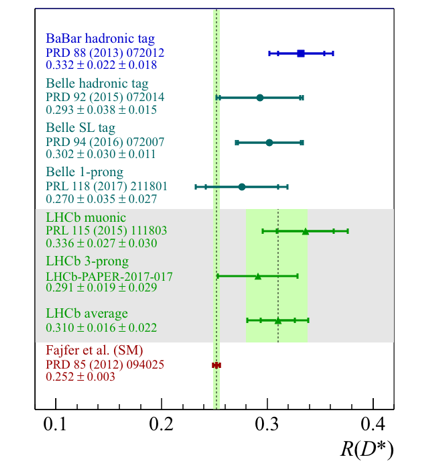Measurement of R(D*): the ratio of branching fractions between B0 → D*-τ+ντ and B0 → D*-μ+νμ using three-prong hadronic τ decays.
[R(D*) in this measurement = 0.291±0.019±0.029; LHCb average = 0.310±0.016±0.022]
Yesterday, at the 15th Flavor Physics and CP violation conference in Prague (Czech Republic), and today at a seminar at CERN, the LHCb collaboration presented the results of a new measurement of the ratio of branching fractions R(D*) = BF(B0 → D*-τ+ντ)/BF(B0 → D*-μ+νμ) using for the first time τ+→π+π–π+ντ or τ+→π+π–π+π0ντ decays. The D*- meson was reconstructed through the D*-→D0(→K+π–)π– decay chain. The result (*) 0.291±0.019±0.029 is characterised by the best statistical uncertainty among any single measurement performed so far, with a central value that is higher than the Standard Model (SM) prediction, although consistent with it at one standard deviation. It is the first time that R(D*) had been measured with these three charged pion decay modes of the τ lepton. This has been possible because of the unique capabilities of LHCb in precisely reconstructing decay vertices. This measurement is affected by different sources of systematic uncertainties, with respect to previously existing analyses, and opens a new avenue to precision studies in the sector of lepton universality with τ leptons. An average of this measurement with a previous LHCb determination using muonic τ decays, τ–→μ–νμντ, gives R(D*) = 0.310±0.016±0.022, which is consistent with the world average and differs by 2.1 standard deviations from the SM prediction.
In the SM all charged leptons, such as taus (τ) or muons (μ), interact in an identical fashion (or, in physicists’ language, have the same “couplings”). This property is called “lepton universality”. However, differences in mass between the leptons must be accounted for. In particular the τ lepton is much heavier than the μ lepton and this leads to a SM prediction for the ratio R(D*) substantially smaller than unity. This ratio is precisely calculable in the SM owing to the cancellation of uncertainties in the ratio, and turns out to be about 0.252 with excellent precision.
The image shows a comparison of different measurements of R(D*). It is interesting to notice that different experiments operating either at pp (LHCb) or e+e– (BaBar, Belle) colliders, using very different experimental techniques, measure values systematically above the SM prediction. The average of all (world) results is brought, by including this new measurement, a little bit closer to the SM prediction and at the same time, due to improved precision, the discrepancy between the experimental world average and the SM prediction increases slightly to about 3.4 standard deviations.
Any measurement exhibiting a conclusive breakdown of lepton universality, after mass related effects are accounted for, would be a clear sign of new physics. The ratio R(D*) is particularly interesting since a large class of SM extensions contains new interactions that involve the third generation of quarks and leptons, like a b quark (from a B hadron) and τ+ and ντ leptons in this case.
LHCb has also found other intriguing anomalies when performing tests of lepton universality. The theoretically very clean ratios R(K) and R(K*) both show deviations from the SM prediction of identical behaviour of muons and electrons at the level of about 2.5 standard deviations. Recently the CERN Theory Division organized a three-day workshop to discuss the interpretation and implications of these anomalies and their potential to shed some light into models of physics beyond the SM.
Both R(D*) measurements were performed at LHCb using the entire Run 1 data sample, corresponding to an integrated luminosity of 3fb-1 at centre-of-mass energies of 7 and 8 TeV. Data collected in Run 2 already provide a sample of B-meson decays more than twice as large, and it will be of great importance to see whether updates of the Run 1 analyses will confirm the discrepancy.
(*) Results updated in the April 2018 publication. More information can be found in the LHCb presentation at the conference, at the CERN seminar. Read more in the CERN update for scientists.

